by Winding Pathways | Mar 9, 2016 | Nature, Trees/Shrubs
Imagine an enormous elephant in the back yard, its huge tusks smashing a tree while it gobbles leaves, branches, and fruits. It once happened! Mastodons, mammoths, camels, horses, and sloths were once native Iowa wild animals before they slipped into extinction some 10,000 years ago.
They dined on the fruit of a long suffering tree that is getting a new lease on life because oil in its seeds promotes beautiful, healthy hair.
The humble Osage orange tree once grew across a vast area of North America. Scrubby, small, and prickly it thrived in poor soil and challenging climates. Today, its range is limited. On its thorny branches grow softball sized warty green fruits often called hedge apples or hedge balls. Without elephants to harvest them they drop to the ground and rot. Any seeds that might sprout can’t grow in their parent’s shade.
Elephants and sloths once devoured these hedge balls and wandered off, digesting the fleshy part and pooping out the seeds a distance from the parent tree. In exchange for a meal the animal planted a new tree generation. Around 13,000 years ago humans appeared and with razor sharp spears decimated the tasty animals. Lacking big mammals to spread its seeds the tree’s range slowly shrank to a small area of Texas and Oklahoma. Then people gave it a helping hand.
Farmers homesteaded the Midwest before barbed wire was invented. They needed fences and planted rows of Osage orange trees that grew into long linear impenetrable tangles. For a while the tree was valued and planted far and wide. When barbed wire was invented it rendered living fences obsolete and the hapless tree again went into decline. Then it got lucky, again.
Now cosmetologists are replacing elephants and farmers as the newest partners of this humble tree. Iowa chemist, Todd Johnson, learned how to extract oil from its seeds. When used as an ingredient in hair care products it promotes healthy hair. According to Capri College of Cosmetology Director of Education, Madison Seaborn, Osage orange oil is used in shampoo, cleansing conditioner, and volumizing gel.
Johnson buys tons of Osage orange fruits from farmers and youth groups and processes them into oil that’s sold to cosmetologists. Once again the Osage orange has value, and it’s likely that people will plant new ones as aging trees die.
Wooly mammoths and mastodons had long fine hair that kept them toasty warm in the cold glacial climate. Perhaps the oil that today is valued as a human hair care product once kept their fur in prime condition.
by Winding Pathways | Feb 2, 2016 | (Sub)Urban Homesteading, Foraging, Nature, Travel/Columns, Trees/Shrubs
Late this winter and early spring dozens of maple syrup festivals will shake the winter blahs. From the Midwest to the Atlantic and from the mid-South to Canada folks will be getting outside as days lengthen and temperatures warm to welcome the season’s first harvest.
Most festivals feature tree tapping and boiling demonstrations as well as delicious pancakes topped with local maple syrup.
-
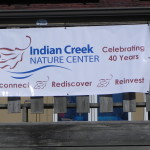
-
For over 40 years, the Indian Creek Nature Center has hosted families at their two day festival.
-
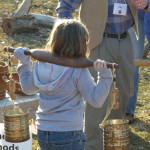
-
Children love to re-live harvesting methods.
-
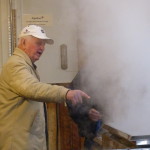
-
Explaining the evaporation process.
-
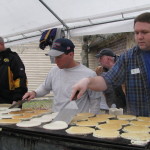
-
Volunteers arrive early at Indian Creek Nature Center’s Festival to serve hungry families.
-
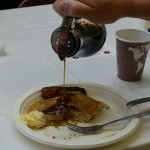
-
Just enough to finish the pancakes and sausage.
-

-
Sweet Surrender!
There’s likely a festival near your home. Just type into your search engine MAPLE SYRUP FESTIVAL IN (your state or province) and details will pop up. Here are just a few:
Indian Creek Nature Center Maple Syrup Festival. Cedar Rapids, Iowa
Indiana National Maple Fest. Brown County, Indiana
Mt. Rogers Maple Syrup Festival. Virginia
Elmira Maple Syrup Festival. Elmira, Ontario, Canada
by Winding Pathways | Feb 1, 2016 | (Sub)Urban Homesteading, Foraging, Nature, Trees/Shrubs
Preparing for the season’s first food harvest is a fun way to spend a few hours during winter’s deep freeze. Cornell University Cooperative and New York’s DNR have an excellent PDF “Maple Syrup Production for the Beginner.” Wikipedia features a comprehensive overview of syruping.
Trees of many maple species will flow sweet sap as soon as daytime temperatures rise into the high 30s while nights drop below the freezing point. That can happen in early February down South and six weeks later in Canada.
Syruping is fun, educational and a wonderful activity to share with children. It can be done far beyond the classic syruping regions of New England, Canada and the Lake States. We’ve been in touch with families from North Dakota to North Carolina who make maple syrup. We’ve made gallons in Iowa. All it takes is a tree or two of any maple species, the right weather and simple tools. When done properly, it doesn’t hurt the tree. Silver, sugar, black, and red maples all run sweet sap. So does the box elder, which is a true maple.
You’ll find past blogs on Winding Pathways that show how to make simple syruping equipment. Type maple syruping in the search box at the bottom of the screen or click on this link. Almost everyone already has everything needed to make small quantities of syrup, but it’s easier and a bit more sanitary to use manufactured equipment.
Many companies sell syruping equipment, but most are geared to supply large commercial operations. Tap My Trees is different. They sell easy-to-use equipment to folks wanting to tap a few backyard trees. Their website also includes helpful information on how to tap trees, collect sap, and boil it into syrup. Check it out!
-
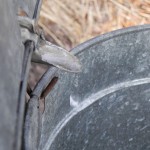
-
Clear sap dripping into the bucket.
-
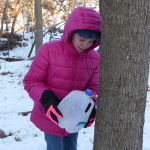
-
A clean milk jug makes a simple “bucket” to collect sap.
-
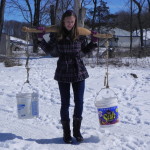
-
Carrying “modern buckets” on a yoke.
-
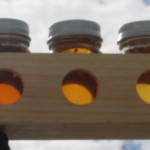
-
Maple Syrup’s taste is stronger with a deeper amber.
-
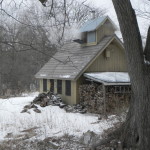
-
A traditional sugar shack
-
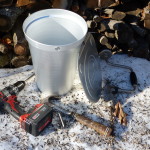
-
Modern equipment make backyard syruping easy and pleasurable.
by Winding Pathways | Jan 30, 2016 | Nature, Trees/Shrubs

Catalpas are tough trees that thrive in hostile environments. Their beautiful blooms attract pollinators.
We recently invited our neighbors to Winding Pathways for an evening of conversation. It was early winter and talk turned to trees.
“We have an odd tree growing in our yard. I have no idea what it is, but it has bit heart shaped leaves and later in the summer long beans dangle down from it,” said Patty a neighbor from down the street.
Her description was perfect. It was a Northern Catalpa. No other tree matches her observations.
Winter is a wonderful time to study trees. In midsummer their branch structure and twigs are usually invisible beneath leafy clothing. Not so in winter when buds, twigs, trunk, and branches can be easily seen. Often they yield clues revealing its species.
One of our favorite tree finding tools is on the Website of the National Arbor Day Foundation. Click on the “tree” tab and a simple identification guide pops up like magic on the computer screen. The Arbor Day Foundation also sells dozens of tree species at reasonable prices and a visit to Arbor Day farm in Nebraska City, Nebraska is memorable. It’s just south of Omaha and is where J. Sterling Morton founded Arbor Day.
by Winding Pathways | Sep 12, 2015 | Mammals, Nature, Pests, Trees/Shrubs
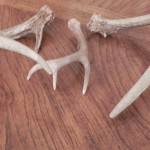
A pair of winter sheds all polished.
One year at Winding Pathways we planted a few trees and tended them all summer. They were doing great until one September night. A buck deer decided that our new trees were perfect for rubbing off the velvet that covered his newly formed antlers. Just a few minutes of determined rubbing killed our precious trees!
Deer antlers start growing in early spring and by late August are fully formed. Velvet on the outside of the growing antlers is rich with blood and minerals. By September its purpose is done. Bucks rub the velvet off to prepare their antlers for battle with rivals when the mating season starts in November.
Deer have the uncanny knack of rubbing the most valued trees in a yard, and often they remove all the bark, thus killing the tree.
Fortunately, damage is easy to prevent. Just drive fence posts into the ground a few feet out from the tree and attach wire mesh to them to physically keep deer away. Plastic tree guards that attach directly to the trunk also help prevent damage.
Do this now before the deer start to rub. Or you may lose all your new trees in just one night.
by Winding Pathways | Jul 6, 2015 | Nature, Trees/Shrubs
Each summer a small tree in our yard produces more delicious cherries than we can harvest and eat.
Tart cherries are outstanding yard trees. They are small, attractive, need little care and begin bearing fruit when only a couple of years old. Trees self-fertile, meaning it’s not necessary to plant two or more for cross pollination. Few insects or diseases bother them but sometimes birds, especially robins, take a fancy to the bright red fruit. Birds prefer mulberries to cherries so we keep a mulberry in the yard as our decoy tree to keep birds from filching cherries.
Commercial nurseries sell two general types of domestic cherry trees-sweet and sour (sometimes called tart or pie cherries). Sweet cherries don’t like subzero winters and are best grown in places warmer than our Iowa yard. The fruit is commonly sold in grocery stores and is delicious fresh. Most varieties need a second tree for cross pollination. In contrast tart cherries don’t seem to mind occasional 25 below zero temperatures and thrive in the north. Rarely sold fresh in stores, tart cherries can usually only be purchased canned. To enjoy delicious fresh tart cherries grow your own.
Two common tart cherry varieties we like are Montmorency and Dwarf North Star. Both produce tasty fruit. Sometimes the fruits are sweet enough to eat right off the tree. But usually their tartness makes them best when used in pies, cobblers, and other baked goods. We like them in our morning oatmeal.
The downside of cherries is the time it takes to pick and pit the small fruits. It can be tedious. Dwarf trees reduce or eliminate the need for ladders, making picking safe, fast and easy. We used to hand pit the fruits using fingers to squeeze the large seed out of each cherry. After a few years of this slow process we bought a cherry pitting device that speeds and eases the process, but it still takes time.
Pitted cherries freeze well. Put a big handful in a plastic freezer bag, squeeze out the air, seal the bag and put it in the freezer to retrieve months later when the urge for cherry pie arises.














